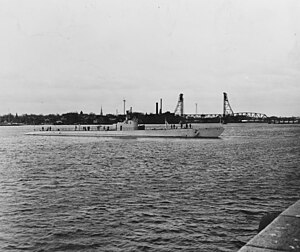USS Cachalot (SS-170)

USS Cachalot SS-170
|
|
| History | |
|---|---|
|
|
|
| Name: | USS Cachalot |
| Namesake: | sperm whale |
| Builder: | Portsmouth Naval Shipyard, Kittery, Maine |
| Laid down: | 21 October 1931 |
| Launched: | 19 October 1933 |
| Commissioned: | 1 December 1933 |
| Decommissioned: | 17 October 1945 |
| Struck: | 1 November 1945, reinstated 28 November 1945, stricken again 8 July 1946 |
| Fate: | Sold for breaking up, 26 January 1947 |
| General characteristics | |
| Class and type: | V-8 (Cachalot)-class composite direct drive diesel and diesel-electric submarine |
| Displacement: | 1,110 tons (1,130 t) surfaced, standard, 1,650 tons (1,680 t) submerged |
| Length: | 271 ft 11 in (82.88 m) |
| Beam: | 24 ft 11 in (7.59 m) |
| Draft: | 16 ft 3 in (4.95 m) maximum |
| Propulsion: |
|
| Speed: | 17 kn (31 km/h) surfaced, 8 kn (15 km/h) submerged, 7 knots (13 km/h) submerged, service, 1939 |
| Range: | 6,000 nautical miles (11,000 km) @ 10 kn (19 km/h), 14,000 nmi (26,000 km) @ 10 kn (19 km/h) with fuel in main ballast tanks, 83,290 US gallons (315,300 L) oil fuel |
| Endurance: | 10 hours at 5 kn (9.3 km/h) |
| Test depth: | 250 ft (80 m) |
| Complement: | 6 officers, 39 enlisted (peacetime); 7 officers, 48 enlisted (war) |
| Armament: | 6 × 21 inch (533 mm) torpedo tubes (four forward, two aft, 16 torpedoes), 1 × 3 inch (76 mm)/50 caliber deck gun |
USS Cachalot (SC-4/SS-170), the lead ship of her class and one of the "V-boats", was the only ship of the United States Navy to be named for the sperm whale. Her keel was laid down by the Portsmouth Navy Yard. She was launched on 19 October 1933 as V-8 (SC-4) sponsored by Miss K. D. Kempff, and commissioned on 1 December 1933 with Lieutenant Commander Merril Comstock in command. Cachalot was the first submarine to have the Torpedo Data Computer, Arma Corporation's Mark 1, installed.
Cachalot was built by the Portsmouth Navy Yard, as were most of the previous V-boats. She differed from her sister Cuttlefish (the first submarine built entirely by Electric Boat) mainly in retaining the riveted (vice welded) construction of most previous submarines. Both were medium-sized submarines built under the tonnage limits of the London Naval Treaty of 1930. An extensive study was conducted to determine the optimum submarine size under the treaty restrictions, factoring in total force, endurance, and percentage of the force that could be maintained on station far from a base, as in a Pacific war scenario. Despite the calculation process, size reduction had gone too far with the Cachalots, limiting their patrol endurance. After three Pacific war patrols, Cachalot was relegated to training duties in September 1942, once numerous Gato-class boats became available.
The as-built engine specifications were two BuEng-built, MAN-designed M9Vu 40/46 nine-cylindertwo-cycle direct drive main diesel engines, 1,535 hp (1,145 kW) each, with one BuEng MANtwo-cycle auxiliary diesel engine, driving a 330 kW (440 hp) electrical generator. The auxiliary engine was for charging batteries or for increased surface speed via a diesel-electric system providing power to the main electric motors. As with most V-boats, the main engines proved troublesome, and were replaced in 1937-38 by two Winton GM 16-278 16-cylinder four-cycle diesels, 1,600 hp (1,200 kW) each.
...
Wikipedia
